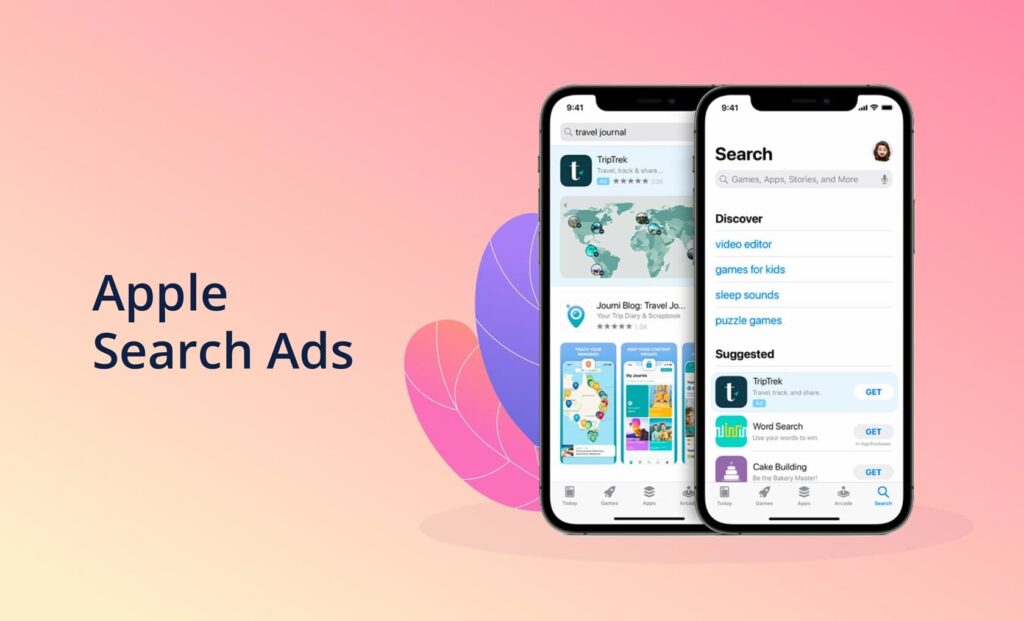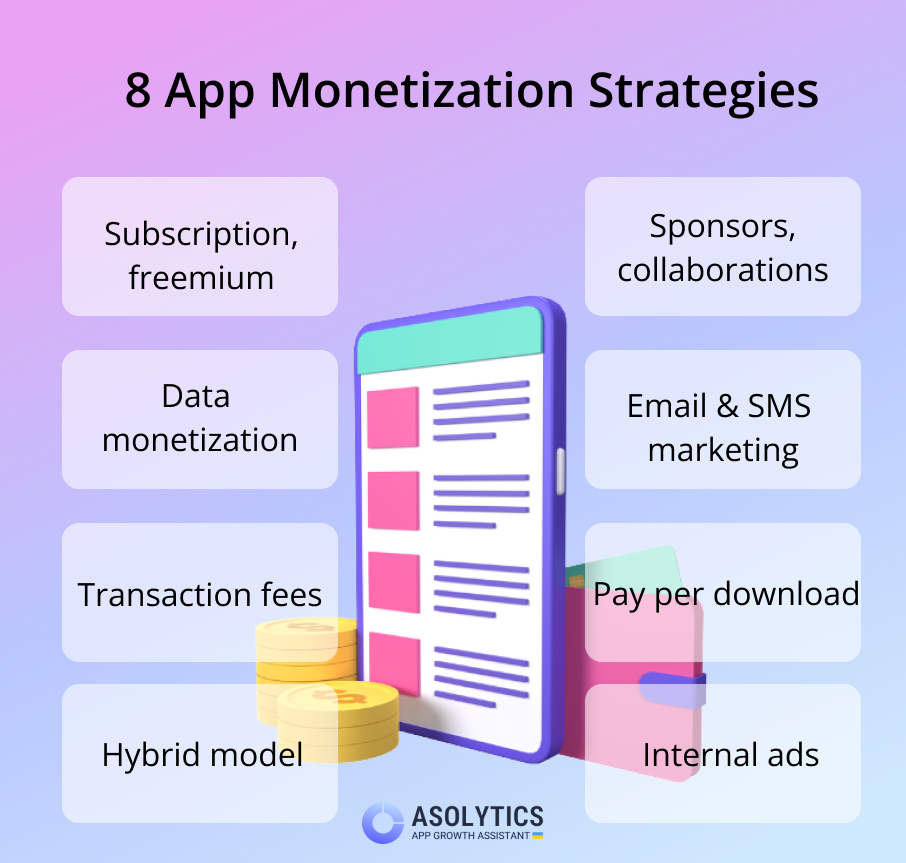‘There are so many ways to add value to people’s lives. But what’s also important is monetization. The key is to find that balance where your business is efficiently monetizing the value that it’s adding.’ This wise quote by Hendrith Vanlon Smith Jr, CEO of Mayflower-Plymouth, rings true when it comes to monetizing your top-notch mobile app. So monetize app store with that balance in mind? We’ll let you in on it in today’s post.
Table of Contents
Let’s imagine нou’ve designed your own mobile startup. Finally! Now, your core consumers are free to establish one-of-a-kind interactions with you. You can improve things even more: earn cash from your creation. Because your app is much more than just a niche-oriented instrument. It’s what can bring you money and aid you in amplifying your business.
The mobile application scene does offer some tempting freebies but in a very limited form. In order to survive in the highly competitive environment, mobile brands introduce paid functionality. That’s basically what allows them to succeed and scale. To get the gist of how to monetize an app, we have to delve into the topic of how teams behind mobile software bring in excellent earnings.
In this comprehensive mobile app monetization guide, we will:
- define mobile app monetization;
- delve deep into why app monetization is important;
- let you in on how to get ready for app monetization;
- cover the best app monetization strategies;
- provide real-life examples of effective app monetization models;
- teach you how to choose the best-suiting app monetization model in your case;
- share the most popular mobile ad networks;
- dwell upon the app monetization vs. user experience topic;
- provide tips on how to measure your app monetization success;
- provide wise quotes and thoughts of various tech pros that shape the essence of mobile app monetization and its relation to user satisfaction;
- as well as answer some of the most frequently asked questions about app monetization.
By the way, we have already shared our experience about the best way to monetize mobile games. So, are you ready to transform your application into a profit-making machine? We’ve got you covered. Keep reading for some powerful knowledge on the topic.

What Is App Monetization?
In simple (and brief) terms, it’s a set of tools utilized to convert your core app audience into profit. Because each niche and each product is unique, the most suitable mobile app monetization strategy for you may differ from that of your opponents.
These days, the installation of most applications is free of charge. Therefore, you’re going to need to adapt your cash-attracting model to gain profit after your consumers install the app. Ensuring that your app brings both client satisfaction and sufficient income is paramount at the very first stages of creating your business plan.
If you want your project to reach its full potential, you’re going to engage in some experimentation in order to nail down the right answer to the ‘How to monetize a free app?’ question in your particular situation. With some patience and the will to learn fast, as well as with the Asolytics pro tools and hacks at your fingertips, you are sure to succeed in Android and iOS app monetization. With us, you’ll also learn how to get featured on the App Store.

You can get an evaluation of how well your text and visual assets are adapted to the store in your app’s Dashboard
Why Is Monetize App Store Important?
Although a multitude of mobile software is installed for free, it doesn’t stop people from trusting the worthiest mobile brands with their money. ‘Trusting’ being the key word here, for users will only invest money in a high-quality offering and the business behind it they can trust. Knowing and utilizing monetization strategies for mobile apps in a knowledgeable way is crucial for a slew of reasons.
Below, we’ve listed the main reasons why implementing Android and iPhone app monetization strategies is crucial:
- It aids you in bringing stable income flow in.
- It helps you establish meaningful relationships with your consumers.
- It contributes to your company’s growth.
- It stimulates you to refine your product to perfection.
- It aids you in becoming a leader in your niche.
How to Prepare for App Monetization
One thing is crystal clear: there’s no one-size-fits-all strategy. Each mobile startup needs a customized plan that naturally comes with a multitude of perks and drawbacks. With that said, the best-fitting ways to monetize apps differ from one company to another.
Begin by assessing your business model thoroughly. Know exactly how you want your application to be utilized, as well as its strongest and weakest sides. Furthermore, study and always remember your consumers’ needs and behavior patterns. This will assist you in pinpointing the highest-performing profit-generating strategies in your situation.
Explore your competition. Take a closer look at their monetization background. Study their successes and do your best to avoid the mistakes they’ve made. Look up to the best. Get to grips with their iOS and Android app monetization strategies. Then decide which of them will assist you in skyrocketing your product to financial stardom.
8 App Monetization Strategies That Work Like a Charm
How can I monetize my app the right way? If you’re asking yourself (and Google) this question, we have all the answers you’re on the prowl for. Attracting cash via your mobile startup is an interesting and hugely rewarding process. But only if you approach it in the wisest and most knowledgeable way possible. Below, we’ve rounded up 7 top-of-the-line revenue-raising tactics to utilize to your maximum benefit and avoid ASO cannibalization along the way.

- Internal Ads: Easy and Potentially Annoying
We’re sure you’ve noticed those in-app ads that pop up whenever you start playing your favorite mobile game. A breeze to implement? Yes? Annoying to people? Definitely. As you can see, this strategy comes with its advantages and drawbacks.
Below, we’ve listed the most widely used in-app ad formats:
- banner ads: usability-wise, they are pretty intrusive;
- video ads: they are displayed within a video stream and are considered very intrusive;
- interstitial ads: you can most frequently see them in-between menus or when a game is loading;
- rewarded ads: they allow you to decide when and how you want to view them;
- native ads: they blend in perfectly well with the app’s content and are more labor-intensive compared to other formats;
- playable ads: they engage users in playing an in-ad mini game and are an excellent choice for advertising mobile games.
Pros:
- works well in tandem with other monetization models;
- a treasure trove of available ad formats;
- ads can be customized to suit a user’s needs;
- allows you to offer the app’s features free of charge;
- best choice for mobile gaming and social network applications;
- there are ad formats that increase user engagement.
Cons:
- requires a stable user base to bring stable profit;
- potentially disruptive and annoying;
- comes with a learning curve.
Despite the obvious drawbacks, recent reports confirm that monetizing your product via in-app ads is a global trend that’s only going to grow more popular.
- Email & SMS Marketing
Both these methods are considered to be outdated, they are still very effective in terms of interacting with your consumers, offering them limited time discounts, letting them know about your top-notch brand new features, building trust with them, and generally boosting your revenue. When utilizing this strategy, be informative, concise, polite, and charming.
Pros:
- email & SMS marketing complements your other monetization options;
- SMS open rates are high;
- nice bonus for your user retention strategy;
- this method leaves room for creativity.
Cons:
- unreliable, especially if you opt for this strategy only;
- some users will inevitable label this approach as spam;
- comes with a learning curve.
- Subscription/Freemium
Generate income from your app by using subscriptions. In accordance with this popular model, your target audience gets to install your application free of charge and use its entire functionality during a trial period. When this period is over, and the user wants to continue utilizing the product limitlessly, a sign-up is required. So, if you’re curious about how to monetize an app without ads, this method can easily fit you like a glove. In our Guide on In-App Purchases and Subscriptions, you can read more on the topic.
Pros:
- your users get the possibility to get a feel of your product without purchasing it;
- secures you a larger audience;
- users only pay for what they need;
- bolsters user engagement and app retention;
- better income channel in comparison to in-app ads.
Cons:
- requires client support;
- converting free users to paying users is hard work in this case;
- supporting a non-paying audience is far from profitable.
- Sponsors and Collaborations
Want to know how to get companies to advertise on your app? Seek organizations that may have plans for your startup and initiate mutually beneficial collaboration with them. These partner organizations of yours, in their turn, will reward your most active users with discounts or special offers. This will boost your partner’s income and grant you a share of the profit they get from the endeavor. Definitely a win-win situation.
Pros:
- promising revenue-boosting potential;
- comes with added value for your app;
- less aggressive in comparison to other models;
- is easily combinable with other monetization methods.
Cons:
- requires a stable user base and reputation;
- success levels are uneasy to predict due to this method being rather new;
- this income channel is inconsistent;
- requires thorough vetting of partners and sponsors.
- Data Monetization
What are mobile app monetization models used by some well-known companies? Earning cash from selling important info! The importance of 1st-party data (your users’ whereabouts and behavior patterns) is never underestimated. It’s extremely valuable. Marketing specialists are constantly on the prowl for this data because it helps them get under their core audience’s skin. Uber is among this strategy’s aficionados. The company openly sells its client location details to other platforms.
Pros:
- the value of data grows nonstop;
- a breeze to set up and get started;
- ‘makes good friends’ with user experience;
- reliable monetization model with a solid scaling potential.
Cons:
- users aren’t ready to reveal their data;
- comes with the need for an extensive user base;
- some legal gray zones are in need of clarification.
- Transaction Fees
If multiple payments are constantly being made within your startup, this particular mobile income-attracting method might be your best bet. Such corporations as Uber, Amazon, eBay, and many others excel in utilizing payment fees as one of their major monetization models.
Pros:
- easily predictable revenue;
- the possibility to charge both vendors and consumers;
- if you approach this technique right, you will offer stable user convenience.
Cons:
- requires significant investment;
- high transaction fees mean bye-bye customers.
- Pay per download
This model comes down to charging users for downloading your app(s). The higher your prices, the more revenue you’ll bring in, it’s natural. Just make sure you don’t overcharge here, for this may lead to losing your loyal consumers to your competition. Always ensure that what you offer is worth what you charge for it. Remember that these days, pay per download is not the most popular monetization strategy. But it does come with some yummy perks.
Pros:
- strengthens customer loyalty;
- competition is pretty mild;
- quicker return on investment.
Cons:
- requires client support;
- not so easily combinable with other monetization models;
- unreliable income channel.
- Hybrid model
This monetization model combines two or more aforedescribed models. To implement it, you’re going to need to think in advance and plan a lot. It also requires a lot of testing and experimentation. However, if you opt for the best strategy here, your chances of boosting your revenue are enormous. The idea around this model is simple: the combination of monetization strategies equals a widened audience and combined success.
Pros:
- expands your audience significantly;
- comes with high levels of flexibility;
- potentially highly profitable;
- excellent choice for gaming and streaming apps.
Cons:
- requires extensive strategizing;
- comes with a learning curve;
- if done wrong, can deter users instead of attracting.
How to Choose the Best App Monetization Model for You
Choose the most effective app monetization model as if you’re choosing the right key for a lock – because it unlocks your product’s potential for success. Warren Buffett once wisely noted, ‘Price is what you pay; value is what you get.’
Follow these tips to opt for app monetization models and strategies that suit your case best:
- First and foremost, you need to know your users inside out. It will help you make the best choices, monetization-wise. For example, to monetize a mobile gaming app that boasts a young and tech-savvy target audience, choose generating revenue from in-app purchases and ads. If monetizing a productivity app for professionals is your goal, then a subscription-based money-making model is a wise choice.
- Focusing on one source of income is risky. Therefore, we recommend that you broaden your income channels. It means that you should opt for several monetization models instead of one. For example, a combination of in-app purchases and ads is a fine multi-model approach to app monetization.
- Strike a balance between making money and offering excellent user experience. Your application will only deter users if you clutter it with annoying ads or practice aggressive upselling. To succeed, opt for unobtrusive, relevant ads or in-app purchase opportunities that make your users feel okay — or even expand their horizons.
- Remember that what works today may not work tomorrow. With that in mind, to polish your app monetization approach, you should analyze your app’s performance and user feedback on a regular basis. Test an array of revenue-boosting models. Experiment with various tools. Take risks. Adapt your strategy to the most current market trends. In other words, work on monetization nonstop if success is what you’re aimed at.
Choosing the Best Mobile Ad Network for App Monetization
If you opt for the right mobile ad platform, consider you’re halfway through a successful monetization path. There’s a treasure trove of mobile ad networks to choose from. Aside from the fact that it needs to be compatible with your app’s essence, the perfect platform should also resonate with your main goals. What’s your top priority today: user acquisition or revenue generation? Consider this before making your final choice.
Below, we’ve outlined some of the most well-known mobile ad networks:
- Facebook and Instagram Ads. The juiciest perk you get here is access to a huge user base. By making the most of this platform, you’ll enjoy targeting users by such parameters as age, education, interests, and the like.
- Google AdMob. This platform is excellent if increasing income from your mobile gaming app is your ultimate goal. Even if you’re an amateur, you’ll easily get to grips with its functionality and opt for what’s best for you.
- Unity Ads. If you’re a mobile game developer, this network is your best bet.
Applovin. This platform is for you if you’re a developer who aims at analyzing your audience and attracting high-value consumers.
App Monetization vs. User Experience: 10 Best Tips
‘Designing your product for monetization first, and people second will probably leave you with neither’. These words by Tara Hunt focus on one major idea: app monetization is dysfunctional without user experience. Keep reading to grasp it on a deeper level.
Just like the ASO vs SEO issue, app monetization vs. user experience are in many ways opposable notions. Here’s why. If implemented in a hasty or improper manner, most app monetization strategies will destroy your user experience. Follow these useful tips to prevent that from happening:
- Create User-Centric Design. In the words of Frank Chimero, ‘People ignore design that ignores people.’ Therefore, you should always put user experience first. Clean and intuitive interface is a must. Do away with distractions or annoying nuances. Uber is the champion here. It provides a straightforward interface which makes requesting rides the smoothest experience.
- Transparent Data Management. Be honest with your users about how you collect and use their sensitive data. That way, you’ll easily build trust with them. Take WhatsApp, for example. They offer a very detailed explanation of their privacy policy.
- Do Not Use Intrusive Ads. Opt for formats that don’t interrupt your users from enjoying your application. In this respect, banner ads and native ads have a high chance of seamlessly blending in with your app’s content. Learn from Instagram’s smooth way of sponsored post integration into users’ feeds.
- Focus on User-Initiated Personalization. Instead of aggressive tracking, allow your app users to let you know about their needs first hand. Take Netflix, for instance. They offer personalized recommendations based on user behavior and explicit ratings.
- Make In-App Purchases Valuable. If you use in-app purchases as a monetization model, make sure these app purchases reflect your users’ needs. Remember Candy Crush and its mouth-watering gameplay-boosting power-ups and bonuses? People buy it all just because they want to! Learn from that monetization approach.
- Segment Users for More Relevance. That way, your users will only see promotions they want to see within your app. Amazon is the winner here, because it customizes product recommendations based on users’ browsing history and purchase patterns.
- Offer Free Trials. If you’re practicing a subscription-based monetization strategy, this approach is recommended. Take Spotify, for instance. They offer a 30-day free trial for their premium service.
- Ask for Feedback. And Act Upon It. Work up a platform where your users will share their opinion on your product with you. Be a good listener. And don’t forget to make the necessary in-app improvements based on that valuable feedback. Airbnb is a success in this context. They value user reviews and ask guests to leave detailed feedback about their experience.
- Release Regular Updates. Fix bugs and add useful features nonstop. This will keep your app fresh and take its overall performance to the next level. Users love it when apps get better with time. Remember how often Apple releases iOS updates? That’s what we call effective polishing. And it smoothes out your user’s experience in a major way!
- Respect Your Users’ ‘No.’ When people say they don’t want their data used for ads, it’s important to listen and follow their wishes. Otherwise they will lose trust in you (read as they will stop trusting you with their money). Facebook, for example, lets users control their ad settings and data use.
With all that said, remember one sacred truth: the customer is king. Go the extra mile to give them what they want. And only then worry about how much money you’ll earn from it. Just like Blake Ross aka Mister Firegfox, Co-creator of Mozilla Firefox, once said, ‘The next big thing is the one that makes the last big thing usable.’ Keep that in mind when finding that sacred balance between your product’s ‘value-ability’ and profitability.
Tips for Measuring Your App Monetization Success
Trying to evaluate how successful your app monetization efforts are but to no avail? Does it feel like steering a ship through unknown waters? Let’s admit it. You’ll find yourself adrift without the best tools at your disposal. Follow these expert tips to make sure your monetization strategy is on the right course:
- Know exactly what you want
Define your goals before setting sail. Is it high income? Large user base, perhaps? Or is it user engagement? This first step will shape your success metrics. - Monitor vital KPIs
If you’re aimed at maximized monetization, the following Key Performance Indicators are definitely worth analyzing:
Cost Per Click (CPC);- Cost Per Installs (CPI);
- Cost Per Action (CPA);
- Average Revenue Per User (ARPU);
- Customer Acquisition Cost (CAC);
- Cost Per Acquisition (CPA);
- Customer Lifetime Value (CLV);
- Time of First Purchase.
- Assess user retention
If you read our blog on a regular basis, you should know by now that user retention is more important than user acquisition. With a high churn rate, your chances of sinking your ship drastically grow. Therefore, if a lot of users leave your app without even a proper good-bye, you should thoroughly analyze the ‘whys’ around this issue. - Analyze your app’s conversion rate
For example, if you have a fitness app that offers premium workout plans, your analysis should focus on the following question: ‘How many users upgrade from the free to the paid version?’

To track and analyze your mobile game, use Analyze App Asolytics tools
- Practice split testing
Compare the performance of your chosen monetization models by conducting Android and iOS ASO A/B tests. For example, if you have a news app, you should test two different ad formats to conclude which one is more profitable and less intrusive. - Practice analytical comparison
Compare your app with your strongest competitors. Then analyze the resulting insights. This will help you clearly see where exactly you stand and pinpoint what should be improved to achieve a better position. - Communicate with your users
Do it by conducting user satisfaction surveys, for example. Ask your audience about their opinion on your monetization methods. That way, you’ll get the chance to polish your approach without compromising one crucial aspect: user experience.
‘The best way to predict the future is to create it.’ This wisdom often attributed to Abraham Linkoln can be directly linked to the topic of measuring your app monetization results. If you set clear objectives, monitor vital KPIs, and stay flexible now, you are guaranteed to get profitable results in the future. When sailing these uncharted waters, always remember that it’s not just about turning your app into a money-maker. Your audience’s satisfaction and trust are very important, too.
Bottom Line: Your Efforts Will Pay Off
Making a profit from one’s mobile creation is every dev team’s priority. Intensive labor should bring handsome rewards, it’s more than natural. Whether your app is meant to be your passion or direct source of income, the issue of how to monetize the app on Play Store is worth delving into. In this piece, we let you in on 8 surefire strategic plans for you to explore and implement.
Always remember that the process of earning money from your mobile startup is closely related to the notion of app marketing in general and ASO in particular. If you optimize your brand both inside and beyond your app, you are sure to generate more leads and thus increase your income-boosting chances in the most effective way possible.
The Asolytics team is here to help you with that and provide you with all the necessary instruments and mobile app categories statistics you need. Let our platform become your go-to hub for the tools that will elevate your efforts to a brand new level.
FAQ
What is app monetization?
It’s the process of making money from your mobile application by using an array of strategies that best suit your product’s essence and need.
Why is mobile app monetization important?
Because it stimulates the natural process of reaping the perks from your creation. If done correctly, app monetization focuses on perfecting user experience. When achieved, this perfect balance contributes to the app’s overall growth and profitability.
How do I monetize my mobile app?
If approached properly, the following strategies and models will turn your app into a money-maker: in-app ads, subscriptions, and/or in-app purchases. You can combine several strategies in one approach, which will double up your results. The best tip here is to maintain a solid balance between using your app to make money and providing your consumers with a truly pleasant and useful experience.
What are some other app monetization strategies examples?
Along with displaying ads with your app or streaming service app subscriptions, there are other mobile app monetization methods. Different fintech app monetization strategies may revolve around transaction fees, offering financial tools, or premium account features.
What monetization model suits my app best?
The answer to this question depends on your product’s value proposition and your target audience’s needs. If your app is free and boasts high traffic, make the most of in-app advertising. If your app offers valuable content or services, the in-app purchases-based model is right up your street.
How to monetize an app with ads?
First and foremost, choose a reliable ad network like Google AdMob or Facebook Audience Network. Opt for the most non-intrusive ad formats like banner ads or native ads. The ads you’ll choose should blend in well with your app’s content. Avoid displaying those ads too frequently to prevent them from annoying your audience. Assess ad performance on a regular basis. It will help you boost revenue while maintaining a satisfying user experience.
Why is the hybrid monetization model so good?
Because it feels like a cocktail of well-blended money-making methods. Nice, isn’t it? Hybrid monetization can combine, say, in-app ads and subscriptions in one reliable and effective revenue-boosting strategy. If implemented correctly, this crowd-pleasing monetization model is powerful enough to both make your users happy and bring your long-awaited profit.
What’s the secret to balancing monetization with a great user experience?
Follow these tips to achieve this balance. 1. Choose non-interruptive ad formats. 2. Make sure your in-app purchases are valuable. 3. Treat user privacy with utmost care. Furthermore, don’t forget to work on an intuitive app interface, keep interruptions to a minimum, and act upon your user’s feedback.
What role does user satisfaction play in monetization success?
Believe it or not, this parameter is very important. Satisfied users tend to stay closely connected to your app and support whatever monetization strategy you choose. If you want to achieve user satisfaction, ask your audience to leave feedback and refine your product based on that feedback.
How can I adapt my monetization strategy over time?
Treat the mobile app market as a living organism. It breathes and it shifts into something new all the time. That said, you need to keep track of its dynamics and adapt your ways accordingly. This process suggests a lot of performance analysis, user feedback assessment, and user preference prioritization.
What are the best mobile ad networks in 2023?
Give Facebook/Instagram Ads, Google AdMob, Unity Ads, and Applovin a try. It is our well-justified choice. Why? Because we’re experts with years of experience under our belts in successful mobile marketing and app monetization — and believe us, we’ve tried it all!
What metrics should I track to evaluate monetization success?
When it comes to analyzing the success of your revenue-boosting approach, the following KPIs are worth your attention: Average Revenue Per User (ARPU), Customer Lifetime Value (CLV), user retention, and conversion rate. You want to see a bigger picture? Then don’t forget to analyze your user behavior patterns and compare your product with competition. Specialized time-saving digital tools like Asolytics will effectively help you with that.




